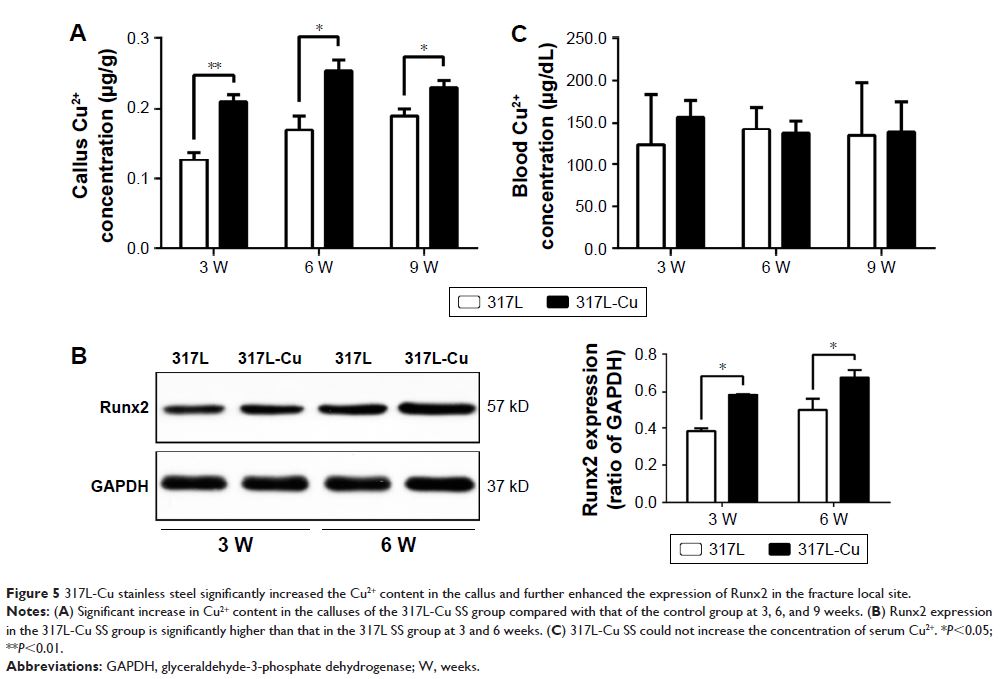9 7 8 1 6
论文已发表
注册即可获取德孚的最新动态
IF 收录期刊
- 3.3 Breast Cancer (Dove Med Press)
- 3.4 Clin Epidemiol
- 2.5 Cancer Manag Res
- 2.9 Infect Drug Resist
- 3.5 Clin Interv Aging
- 4.7 Drug Des Dev Ther
- 2.7 Int J Chronic Obstr
- 6.6 Int J Nanomed
- 2.5 Int J Women's Health
- 2.5 Neuropsych Dis Treat
- 2.7 OncoTargets Ther
- 2.0 Patient Prefer Adher
- 2.3 Ther Clin Risk Manag
- 2.5 J Pain Res
- 2.8 Diabet Metab Synd Ob
- 2.8 Psychol Res Behav Ma
- 3.0 Nat Sci Sleep
- 1.8 Pharmgenomics Pers Med
- 2.7 Risk Manag Healthc Policy
- 4.2 J Inflamm Res
- 2.1 Int J Gen Med
- 4.2 J Hepatocell Carcinoma
- 3.7 J Asthma Allergy
- 1.9 Clin Cosmet Investig Dermatol
- 2.7 J Multidiscip Healthc

已发表论文
含纳米铜的不锈钢通过加速愈合过程促进骨折愈合
Authors Wang L, Li G, Ren L, Kong X, Wang Y, Han X, Jiang W, Dai K, Yang K, Hao Y
Received 20 July 2017
Accepted for publication 17 September 2017
Published 27 November 2017 Volume 2017:12 Pages 8443—8457
DOI https://doi.org/10.2147/IJN.S146866
Checked for plagiarism Yes
Review by Single-blind
Peer reviewers approved by Dr Govarthanan Muthusamy
Peer reviewer comments 2
Editor who approved publication: Dr Linlin Sun
Abstract: Treatment for
fractures requires internal fixation devices, which are mainly produced from
stainless steel or titanium alloy without biological functions. Therefore, we
developed a novel nano-copper-bearing stainless steel with nano-sized
copper-precipitation (317L-Cu SS). Based on previous studies, this work
explores the effect of 317L-Cu SS on fracture healing; that is, proliferation,
osteogenic differentiation, osteogenesis-related gene expression, and lysyl
oxidase activity of human bone mesenchymal stem cells were detected in vitro.
Sprague–Dawley rats were used to build an animal fracture model, and fracture
healing and callus evolution were investigated by radiology (X-ray and
micro-CT), histology (H&E, Masson, and safranin O/fast green staining), and
histomorphometry. Further, the Cu2+ content
and Runx2 level in the callus were determined, and local mechanical test of the
fracture was performed to assess the healing quality. Our results revealed that
317L-Cu SS did not affect the proliferation of human bone mesenchymal stem
cells, but promoted osteogenic differentiation and the expression of
osteogenesis-related genes. In addition, 317L-Cu SS upregulated the lysyl
oxidase activity. The X-ray and micro-CT results showed that the callus
evolution efficiency and fracture healing speed were superior for 317L-Cu SS.
Histological staining displayed large amounts of fibrous tissues at 3 weeks,
and cartilage and new bone at 6 weeks. Further, histomorphometric analysis
indicated that the callus possessed higher osteogenic efficiency at 6 weeks,
and a high Cu2+ content and increased
Runx2 expression were observed in the callus for 317L-Cu SS. Besides, the
mechanical strength of the fracture site was much better than that of the
control group. Overall, we conclude that 317L-Cu SS possesses the ability to
increase Cu2+ content and promote osteogenesis in the
callus, which could accelerate the callus evolution process and bone formation
to provide faster and better fracture healing.
Keywords: nano-sized copper, lysyl oxidase, osteogenesis, fracture healing, callus evolution
Keywords: nano-sized copper, lysyl oxidase, osteogenesis, fracture healing, callus evolution
